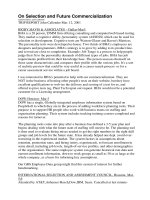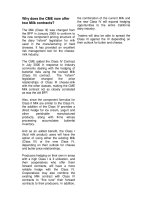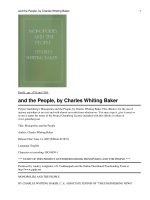hvac inspection notes inspecting commercial industrial and residential construction pdf
Bạn đang xem bản rút gọn của tài liệu. Xem và tải ngay bản đầy đủ của tài liệu tại đây (2.21 MB, 259 trang )
www.TechnicalBooksPDF.com
HVAC Inspection Notes
INSPECTING COMMERCIAL,
INDUSTRIAL, AND RESIDENTIAL
CONSTRUCTION
G. L. TAYLOR
MCGRAW-HILL
New York Chicago San Francisco Lisbon London
Madrid Mexico City Milan New Delhi San Juan
Seoul Singapore Sydney Toronto
www.TechnicalBooksPDF.com
Copyright © 2005 by The McGraw-Hill Companies, Inc. All rights reserved.
Manufactured in the United States of America. Except as permitted under the United
States Copyright Act of 1976, no part of this publication may be reproduced or
distributed in any form or by any means, or stored in a database or retrieval system,
without the prior written permission of the publisher.
0-07-146538-3
The material in this eBook also appears in the print version of this title: 0-07-144888-8.
All trademarks are trademarks of their respective owners. Rather than put a trademark
symbol after every occurrence of a trademarked name, we use names in an editorial
fashion only, and to the benefit of the trademark owner, with no intention of
infringement of the trademark. Where such designations appear in this book, they have
been printed with initial caps. McGraw-Hill eBooks are available at special quantity
discounts to use as premiums and sales promotions, or for use in corporate training
programs. For more information, please contact George Hoare, Special Sales, at
or (212) 904-4069.
TERMS OF USE
This is a copyrighted work and The McGraw-Hill Companies, Inc. (“McGraw-Hill”) and
its licensors reserve all rights in and to the work. Use of this work is subject to these
terms. Except as permitted under the Copyright Act of 1976 and the right to store and
retrieve one copy of the work, you may not decompile, disassemble, reverse engineer,
reproduce, modify, create derivative works based upon, transmit, distribute, disseminate,
sell, publish or sublicense the work or any part of it without McGraw-Hill’s prior
consent. You may use the work for your own noncommercial and personal use; any other
use of the work is strictly prohibited. Your right to use the work may be terminated if
you fail to comply with these terms.
THE WORK IS PROVIDED “AS IS.” McGRAW-HILL AND ITS LICENSORS
MAKE NO GUARANTEES OR WARRANTIES AS TO THE ACCURACY,
ADEQUACY OR COMPLETENESS OF OR RESULTS TO BE OBTAINED FROM
USING THE WORK, INCLUDING ANY INFORMATION THAT CAN BE
ACCESSED THROUGH THE WORK VIA HYPERLINK OR OTHERWISE, AND
EXPRESSLY DISCLAIM ANY WARRANTY, EXPRESS OR IMPLIED,
INCLUDING BUT NOT LIMITED TO IMPLIED WARRANTIES OF
MERCHANTABILITY OR FITNESS FOR A PARTICULAR PURPOSE. McGraw-Hill
and its licensors do not warrant or guarantee that the functions contained in the work will
meet your requirements or that its operation will be uninterrupted or error free. Neither
McGraw-Hill nor its licensors shall be liable to you or anyone else for any inaccuracy,
error or omission, regardless of cause, in the work or for any damages resulting there
from. McGraw-Hill has no responsibility for the content of any information accessed
through the work. Under no circumstances shall McGraw-Hill and/or its licensors be
liable for any indirect, incidental, special, punitive, consequential or similar damages that
result from the use of or inability to use the work, even if any of them has been advised
of the possibility of such damages. This limitation of liability shall apply to any claim or
cause whatsoever whether such claim or cause arises in contract, tort or otherwise.
DOI: 10.1036/0071465383
www.TechnicalBooksPDF.com
The IBC Building Code’s Purpose
“101.3 Intent. The purpose of this code is to
provide minimum requirements to safeguard the
public health, safety and general welfare. . . .”
INTERNATIONAL CODE COUNCIL
www.TechnicalBooksPDF.com
For more information about this title, click here
CONTENTS
CHAPTER 1 INTRODUCTION
1
CHAPTER 2 DESIGN QUALITY CONTROL
Design Quality Control Checklists
Overview
Plans and Specifications
Civil/Site Design Checklists
Storm Drainage Design
Pavement Design Analysis
Landscape Design
Civil/Sanitary Design Checklists
Sanitary Sewers
Water
Design Analysis
Architectural Design Checklist
Structural Design Checklist
Mechanical Design Checklists
Mechanical Design
Fire Protection Design
Fire Alarm Plan
Plumbing Design
Electrical Design
Drawing Checklist
Specification Checklist
IBC Code Requirements
28
28
28
30
32
36
37
37
38
38
39
40
40
44
47
47
48
50
51
52
54
55
57
CHAPTER 3 DUCTWORK
General
Shop Drawings
Fabrication
Installation
71
71
72
72
74
iv
www.TechnicalBooksPDF.com
v
CHAPTER 4 INSTALLATION
Drilling and Notching for Wood Construction
Studs
Joists
Diffusers, Registers, and Grilles
Ductwork Installation
Supports
76
76
76
78
80
81
83
CHAPTER 5 INSULATIONS
General
Identification of Material
Shop Drawings
Surface Burning Characteristics
Material Classes
Ductwork Insulation
Duct Insulation
Duct Mastic
Pipe Insulation
Insulation for Hot Equipment
Insulation for Cold Equipment
Aboveground Pipe Insulation
Piping Exposed to Weather
Underground Pipe Insulation
Cellular Glass Insulation
84
84
84
84
85
85
87
88
89
91
93
94
95
95
96
96
CHAPTER 6 HEATING SYSTEMS
General
Materials and Equipment
Draft Fans and Ductwork
Fuel-Burning Equipment
Fuel-Burning Appliances
Appliance Types
Flame Types
98
98
98
103
104
104
105
106
www.TechnicalBooksPDF.com
Appliance Installations
Clearances for Fuel-Burning Appliances
Clothes Dryer Duct
Decorative Appliances
Venting
Vent and Connector Tables
Direct Venting
Clearances from Combustionables
Draft Fans
108
108
112
113
115
115
140
144
146
CHAPTER 7 FUEL STORAGE TANKS
Miscellaneous Fittings and Equipment
147
147
CHAPTER 8 INSPECTIONS
Planning
Piping
Pipe Insulation
Hot Water Systems
High-Temperature Hot Water
Steam Systems
Hot Air Heating
Heating and Ventilating Units
Unit Heaters
Boiler Specialties Inspection
Boiler Feedwater
Turbines
Combustion Controls
150
150
151
153
154
155
155
155
156
156
157
157
159
160
CHAPTER 9 SUPPLY, RETURN, AND
COMBUSTIONABLE AIR
Return Air
Prohibited Factors
Supply Air
Combustible Air
162
162
162
163
163
vi
www.TechnicalBooksPDF.com
vii
Air from Inside a Building
Air from Outdoors
Combustion and Vent Air
Ventilation Openings
Vents
Types of Vents
Venting Connections
Venting Gas Appliances
Masonry Chimneys
Requirements/Specifications
Chimney Venting
164
164
165
166
173
174
174
175
175
175
177
CHAPTER 10 HEATING AND COOLING EQUIPMENT
General Specifications and Requirements
Carbon Monoxide
Appliance Types
Testing
Operating Instructions and Guaranties
179
179
180
181
182
183
CHAPTER 11 VENTILATING, AIR SUPPLY, AND
DISTRIBUTION SYSTEM
Introduction
Equipment
Fans and Air Handling Units
Power Roof Ventilators
Gravity Ventilators
Ventilator Calculations
Dampers
Filters
Screens
Diffusers, Registers, and Grilles
Balancing and Testing
184
184
187
188
189
189
190
192
192
194
194
194
www.TechnicalBooksPDF.com
Cleaning and Adjusting
Testing
195
200
CHAPTER 12 REFRIGERATION AND AIR CONDITIONING
Introduction
Piping
Refrigerator Piping
Water Piping
Installation
Insulation
Equipment
Introduction
Condensers
Reciprocating Compressors
Centrifugal Compressors
Receivers
Water Chillers
Evaporative Coolers
Unit Coolers
Refrigeration Specialties
Package-Type Air Conditioners
Humidifiers and Dehumidifiers
Absorption Refrigeration Machine
Cooling Towers and Ponds
Pumps
Insulation
Controls
Testing
Types
Painting
Operating Instructions and Guaranties
Mechanical Life Spans
HVAC/Energy Definitions
viii
www.TechnicalBooksPDF.com
201
201
201
201
202
202
204
206
206
207
208
209
210
210
211
211
211
213
216
217
217
218
219
220
222
222
223
224
225
228
1
CHAPTER 1
INTRODUCTION
Up to Code Inspectors Guides comprise a
series of manuals covering different CSI construction procedures and standards for commercial and industrial projects. Although based on
the IBC 2003 and IRC 2003 codes, these
guides are not intended to replace these codes
or any of the other model codes and/or specifications in the contract documents. The goal is
for the Inspector and/or project site managers
to use these guides as a basis for establishing
his or her inspection guidelines, and for providing the client with a well-built project meeting
the specifications. The convenient sizing of
these guides allows the Inspector to carry them
around in a pocket, making code and standards information readily accessible. Furthermore, our intent is for this reference tool to be
instrumental in the construction of better buildings and to be a valuable training guide for
those just entering the construction field. These
guides are valuable tools for architects, engineers, project managers, tradespeople, and
contractors, as well as inspectors.
INTRO.
Copyright © 2005 by
The McGraw-Hill Companies, Inc.
Click here for terms of use.
www.TechnicalBooksPDF.com
INTRO.
REFERENCED MATERIALS
• International Building Code 2003
• International Residential Code 2003
• National Electrical Code (NEC) 2002
• International Fuel Gas Code 2003
• International Fire Codes 2003
• International Energy Conservation Code
2000
• International Mechanical Code 2003
• ACI 318-02/318R-02 Building Code
Requirements for Structural Concrete and
Commentary
• ACI 530/530.1-02/530R/530.1R-02
Building Code Requirements and Commentary for Masonry Structures and Specification for Masonry Structures and Related
Commentaries
• ACI 301-99 Specifications for Structural
Concrete for Buildings
• ACI 306.1-90 Standard Specification for
Cold Weather Concrete
• ACI 305R-99 Hot Weather Concreting
2
www.TechnicalBooksPDF.com
3
• ACI 302.1R-96 Guide for Concrete Floor
and Slab Construction
• ACI 117-90/177R-90 Standard Tolerances
for Concrete Construction and Materials
(AC1117-90) and Commentary (ACI117R90)
• ACI SP-2-99 Manual of Concrete Inspection
• ACI 311.4R-00 Guide for Concrete Inspection
• American Concrete Institute (ACI) 347R
“Formwork for Concrete”
• Americans with Disability Act of 1990
(ADA)
• American Forest Association
• American National Standards Institute
(ANSI)
• American Society for Testing and Materials
(ASTM)
• American Wood Preservers Association
(AWPA)
• APA—The Engineered Wood Association
(EWA)
INTRO.
www.TechnicalBooksPDF.com
INTRO.
One or more International Codes currently
enforced statewide
One or more International Codes enforced within
state at local level
Adopted statewide with future enforcement date
Figure 1.1 ICC CODE ADOPTIONS
• Factory Mutual (FM)
• Truss Plate Institute (TPI) HIB-91
• OSHA Safety and Health (29 CFR 1926),
2003
• Portland Cement Association (PCA) Design
and Control of Concrete Mixtures
• American Society of Concrete Contractors
(ASCC) “Contractor’s Guide to Quality Concrete Construction”
4
www.TechnicalBooksPDF.com
5
THE INSPECTOR’S ROLE
As an Owner’s Representative and/or the
Project Resident Inspector, you should be
thoroughly familiar with all the contract documents, including the plans with all changes,
specifications, and contracts submittals such as
shop drawings. Plans and specifications should
include all revisions, changes, and amendments. In addition, you should be thoroughly
familiar with the project’s reporting requirements as well as the specific duties and responsibilities (including the limits) associated with
the project. Procedures and responsibilities will
differ from project to project. It is crucial that
the Inspector have a clear understanding of
the project’s responsibilities, as well as all
reporting required prior to the start of the
project.
Responsibilities of the Inspector
Inspectors have different responsibilities and
authorities, depending on the organizational
setup, and size and scope of the project. Each
Inspector should be clear on the answers to
each of the following questions:
INTRO.
www.TechnicalBooksPDF.com
INTRO.
❏ Do I understand the limits of my responsibility?
❏ Do I have the technical knowledge required
for this project? Can any gaps in my knowledge be effectively covered with the help of
other inspection staff and or consultants?
❏ Do I fully understand all reporting procedures?
❏ Do I fully understand where I fit in the organizational chart and to whom I report?
❏ Am I given sufficient authority to carry out
my duties and responsibilities?
❏ Make sure you know the extent of your
authority. At a minimum, your responsibility
is to inspect all work and ensure that it’s
accomplished in accordance with the contract plans and specifications. Be sure you
have the authority you need to meet that
responsibility.
❏ Check with your supervisor with respect to
your authority to stop subcontractor operations for safety violations, construction deficiencies, or other potential problems.
Quality Control Issues in the Inspector’s Role
• Subcontractors may be required to provide
additional inspectors in the interest of quality
control either part time or full time, depending on the requirements of the project. This is
especially true for government projects. As
6
www.TechnicalBooksPDF.com
7
the project’s primary Inspector, it is your
responsibility to oversee any additional
inspectors, and to determine their qualifications and ability to perform their duties.
• The main role of the Inspector is to ensure
the owner that the quality requirements of
the contract are satisfied.
• At times, projects will require a Subcontractor Quality Control Program, which is made
up of inspectors responsible for the quality
of each subcontracted aspect of the job. For
example, the masonry subcontractor would
have a masonry inspector, the electrician
would have an electrical inspector, etc.
Although the responsibility for overseeing a
Subcontractor Quality Control Program is
usually the contractor’s, you should develop
a close working relationship with each
Inspector. For some projects, they may
report directly to you.
• Effective project inspections require a serious and concentrated effort on the part of
all the Inspectors, as well as all site management personnel.
CONTRACT REQUIREMENTS
Contract requirements provide the tools for the
accomplishment of the goals. Before the start of
INTRO.
www.TechnicalBooksPDF.com
INTRO.
construction, the Project Manager shall conduct
a meeting of all contractors and discuss their
individual quality control plans and procedures. Construction should not start until the
meeting has taken place, and, at minimum,
until the Project Quality Control plan has been
submitted and accepted. Project staffing should
be sufficient to obtain the quality of construction designed in the plans and specifications.
The following sections describe the methods
for meeting contract requirements.
Preconstruction Meetings
These meetings may be held before each stage
of construction. For example, at the start of
foundations, masonry work, slab on grade,
plumbing grounds, etc., ensure the following:
❏ The requirements are understood by all managers and workers.
❏ The documentation is complete.
❏ The materials are on hand.
❏ The people who are to perform the work
understand what will be considered satisfactory workmanship.
Both the contract specifications and technical
standards referenced in the contract specifications must be in the Job Site Trailer library and
8
www.TechnicalBooksPDF.com
9
available to the inspectors. For instance, the
truss placement specifications depend entirely
on the Truss Plate Institute HIB-91 (TPI) Specifications for all requirements. If the Inspector
doesn’t have the TPI specifications, he cannot
know or enforce these provisions.
Initial Inspections
These inspections must be conducted in a timely
manner at the beginning of a definable feature
of work. A check of the preliminary work will
determine whether or not the subcontractor—
through his Quality Control Manager and the
craftsmen involved—thoroughly understands
and is capable of accomplishing the work as
specified. Check for proper implementation of
safety procedures according to the approved
Safety Plan at this time.
Follow-up Inspections
Follow-up inspections are conducted daily
when work is in progress. This ensures that the
controls established in the earlier phases of
inspection continue to conform to the contract
requirements.
In all projects there is work that is eventually
covered and cannot be inspected after the fact.
INTRO.
www.TechnicalBooksPDF.com
INTRO.
This includes concrete, where the size, number,
and location of reinforcing steel cannot be
readily determined after the concrete is placed.
Underground utilities cannot be inspected after
covering. Work of this nature must be closely
controlled and monitored during construction. If
the contractor was notified to not cover until
you have completed your inspection but does
so anyway, then you can direct him to uncover
the work at his expense!
PLANS AND SPECIFICATIONS
Review of Plans and Specifications
Make a thorough review of plans and specifications before the bidding period.
❏ Watch for omissions.
❏ Watch for discrepancies between plans and
specifications.
❏ Check plans and specifications against
requirements that have been problematic on
similar jobs.
❏ Compare elevations, grades, and details
shown on plans as existing against those at
the actual site.
❏ Report all errors, omissions, discrepancies,
and deficiencies to the Project Manager.
10
www.TechnicalBooksPDF.com
11
Marked and Posted Plans and Specifications
Always keep a posted and marked up
set of plans and specifications convenient
for ready reference. Keep them up to
date!
❏ Make sure that the Subcontractor has this
same information.
❏ Anticipate work operations by reviewing the
plans and specifications for each operation
before it begins.
❏ Discuss contract requirements with the Subcontractor before each construction phase begins.
❏ Highlight and/or make notes of those provisions which need special attention, such as:
(a) Unusual requirements, such as additional
concrete test.
(b) Those requirements overlooked by other
contractors.
(c) Repetitive deficiencies.
(d) Conflicting specifications and drawings.
(e) Code violations.
(f) Use the checklists in the Design Quality
Control chapter to help find significant
items in the plans and specifications.
INTRO.
www.TechnicalBooksPDF.com
INTRO.
REQUIRED GEOGRAPHIC DESIGN CRITERIA
Ground snow load
Roof snow load
Wind speed
Seismic zone
Weathering zone
Frost line
Termite zone
Decay zone
Flood zone
Winter design temperature
Climate zones (energy code)
Heating degree days
Cooling degree days
Radon zone
Exposure profile (wind)
January average temperature
Shop Drawings
❏ Review the prepared subcontractor submittal
register, plans, and specifications. Check submittal register for inclusion of all shop drawings required, including layouts of equipment,
equipment rooms, etc. The Inspector must
have copies of all shop drawings!
12
www.TechnicalBooksPDF.com
13
❏ The Subcontractor is required to enter his or
her data onto the submittal register and submit it to the Project Control Administrator or
others tasked with this responsibility. Compare this submittal with your check list.
❏ The Project Manager is required to periodically review and update the submittal register. The Inspector should monitor each
change.
❏ Check the submittal register to prevent
untimely and omitted submittals so as to avoid
delay of construction. Check specifications for
required turnaround time requirements.
❏ Compare the shop drawings to the contract
requirements and report apparent differences to your supervisor.
❏ Make sure each detail on the shop drawing
is clearly presented.
❏ The Subcontractor must make notes on his
submittal of items that deviate from contract
requirements.
❏ Check material being installed against the
approved shop drawing. (If the Subcontractor installs unapproved material, inform him
or her in writing that the material, if not subsequently approved, will be removed and
replaced at his or her expense.)
INTRO.
www.TechnicalBooksPDF.com
INTRO.
Inspection Report
(a) Prepare a complete and accurate daily
inspection report. Modify the form to reflect all
requirements noted in the specifications and
contract documents. Include the following:
❏ Conditions weather, moisture, soil conditions, etc. Note when and how an
adverse site condition hampered or shut
down a particular operation.
❏ Activities work phases, including locations and descriptions of each activity
and the inspection.
❏ Controversial issues disputes, questionable items, etc. (Also, note if they
were settled and, if so, how they were
settled.)
❏ Deficiencies and violations description, location, and corrective action.
❏ Instructions given and received; identify recipient and source.
❏ Progress information report all
delays, anticipated and actual, and
action taken or contemplated.
❏ Equipment report arrival and departure
of each major item of equipment by manufacturer, model, serial number, and
capacity; report equipment in use and
idle equipment.
14
www.TechnicalBooksPDF.com
15
❏ Reports make sure reports are identified, dated, and signed.
❏ Safety check the daily report each day
for accuracy and to ensure that instructions received are noted.
PRECONSTRUCTION MEETING
Attendees
Both the Inspector and the Project Manager
should attend this conference as well as all contractors’ representatives associated with the
project.
Documentation of Meeting
Minutes of the meeting should be available to
each quality assurance/quality control representative. The subject of the proposed quality
control plan should be well documented.
EQUIPMENT PROPOSAL/EVALUATION
The following issues must be resolved and/or
finalized before start of construction.
❏ Does equipment proposed by the Subcontractor have proper approval for use?
❏ Certain equipment requires a safety test or
check before initial operation at the site.
INTRO.
www.TechnicalBooksPDF.com
INTRO.
❏ Some equipment requires a permit or license
before use.
❏ Have daily/weekly equipment rates been
approved?
❏ Has equipment been recently inspected?
❏ Have all oils, lubricants, and their containers been properly discarded per EPA and
OSHA requirements?
CLAIMS AND DISPUTES
Be sure the following conditions are met:
❏ Always be alert to possible claims or matters
of possible dispute.
❏ When you discover that a claim or dispute is
imminent, notify your supervisor and record
all facts in your (Inspector) daily reports.
❏ Make sure that adequate and accurate
records of facts, materials, labor, and equipment associated with the claim or dispute
are on file.
❏ Situation photographs should be taken to
supplement the record.
❏ Differing site conditions may be cause for a
claim. Subcontractors must notify PM in writing before disturbing conditions.
16
www.TechnicalBooksPDF.com









